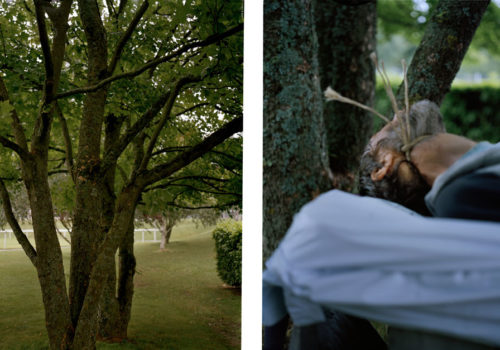Given the scope of his already impressive body of work, it was rather late that I discovered and made the acquaintance of Steeve Iuncker through Gilles Favier. For the first edition of his festival, Images Singulieres, Favier has put together a program of undisputed quality. Iuncker was presenting his raw and disturbing series on cosmetic surgery. He spoke to me of a different series about a young man with AIDS whom he had met and photographed every week until his death. It was a difficult subject, visually intense, that scared publishers away. Last February, Le Bec en l’Air gave this work some well-deserved visibility.
Today Steeve Iuncker is presenting L’instant de ma mort (The Instant of my Death), whose title confirms his willingness to defy, morally and aesthetically, taboo subjects. It is an act of humanity. This is the occasion to pay tribute to the photographer, and in Geneva, whose cultural dynamism isn’t limited to a few timid institutions. Photography occupies a special place in museums like the Centre de la Photographie, directed by the excellent curator and critic, Joerg Bader.
Presented at Mamco as part of the cycle L’Eternel retour (The Eternal Return), featuring works by Yves Bélorgey, Etienne Bossut, Anita Molinero and Franz Erhard Walther, L’instant de ma mort is the latest addition to a study on death. The series is a respectful and head-on representation of lifeless bodies, seen resting (sometimes after a few days) in the places where they had lived. At first glance, some images inspire disgust. Clues in the frame point to a suddenly interrupted life: a bottle sitting on a table, general disorder and modest furnishings offer insight into their past and often difficult lives. With the dramatic and unbelievable ways it is represented on television, death has lost its reality, its color, its smell. Steeve Iuncker has given them back.
This work in the form of diptychs places the body in the space emptied of its physical presence. Traces of blood and rotting, wrinkled sheets, slightly sunken mattresses and, symbolically, a heart drawn in the mud, suggest a continuation of life after its legal end. The expressive positions of the bodies, frozen like the mummies of Pompei, provide a contrast with death’s traditional representations, making it palpable. The Fresson prints on charcoal paper accentuate this materiality.
Laurence Cornet
Cycle L’Éternel Détour, séquence automne-hiver 2012-2013
Steeve Iuncker, L’instant de ma mort
From October 17th, 2012 to january 20th, 2013
Mamco – Musée d’Art Moderne et Contemporain
10, rue des Vieux-Grenadiers
CH-1205 Genève
téléphone : +41 22 320 61 22
télécopie : +41 22 781 56 81
















